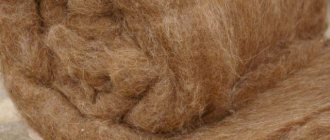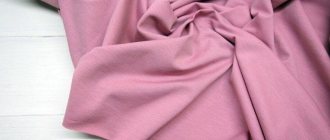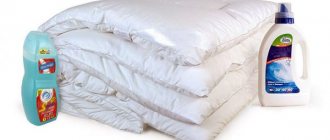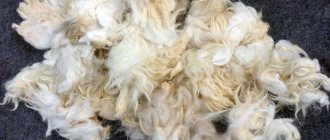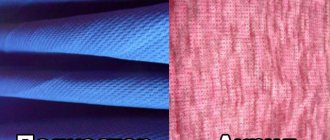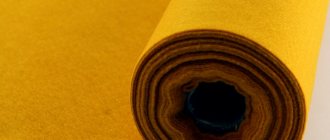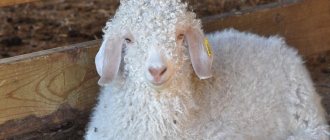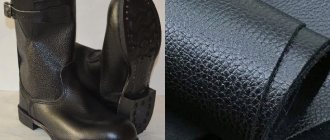Properties of wool in shoes
The most popular material used in the production of shoes is sheepskin. Unlike sheepskin, which is used for clothing, the option for shoes is not as thick. Sheepskin is also very popular among buyers, because it is comfortable and has an attractive appearance, and also has a number of other advantages. This:
- Sheepskin fibers, due to their structure, create a layer of warm air. This helps ensure warmth and dryness;
- The material is completely natural and cannot cause allergies or redness on the skin. Also, sheepskin does not harbor various microorganisms that can harm human health;
- Sheepskin has anti-inflammatory properties. The substances included in its composition provide an antiseptic effect. And thanks to lanolin, which is contained in wool hairs, swelling of the lower extremities is relieved;
- Hygroscopicity. Sheepskin is quite difficult to get wet. It can remain dry even with prolonged exposure to water;
The disadvantages of sheepskin include:
- High price. This is the most expensive lining material;
- Low wear resistance. During wear, the sheepskin begins to be trampled and worn out, which is why it loses its heat-saving properties;
Tips for choosing shoes with fleece inside
It is recommended to purchase shoes with such a lining for the long transitional season, when the temperature has not yet risen above 10°C . When choosing shoes with this type of lining, it is recommended to pay attention to the density of the material. A high-quality bike should have thick pile and a dense structure. The lining should not have a strong specific odor, and no traces of paint should remain on the hands.
Shoes with flannelette lining are most often chosen by people who value warmth and comfort and prefer natural fabrics. Due to its reasonable price, such shoes are available to a wide range of buyers.
Properties of fur
Fur, which is used to insulate shoes, can be natural or artificial.
Artificial
This is a completely synthetic material that only imitates a natural product. It consists of a base and pile. Despite the fact that this is faux fur, it has recently become very popular among buyers. This is due to the following:
- Low cost compared to natural analogues;
- It is completely environmentally friendly;
- In appearance it is not inferior to natural products;
- It can be painted in various colors, which can serve as an excellent decoration for shoes;
- It is quite easy to care for;
However, it has a significant drawback. Since this is a synthetic material, it is airtight and the skin does not breathe in it, which leads to increased sweating.
It consists of 80% natural wool, and the remaining 20% synthetic fiber.
Thanks to this combination, all the advantages of natural fiber are preserved, while giving it additional strength.
Wool fur has the following advantages:
- Hygroscopicity. The fiber retains moisture well;
- It allows the skin to breathe;
- Since sheepskin is used in production, the fur has some antibacterial properties, and also contains lanolin, which relaxes the leg muscles;
- Due to the presence of synthetic fiber, such products have excellent wear resistance;
- The material is very light, which reduces the weight of the products;
- Costs less than natural sheepskin;
These shoes will be an excellent option for all car enthusiasts, as they are lightweight and your feet will not sweat.
As you can see, the material has no disadvantages, so it is optimal when choosing shoes.
Whichever of the three materials is used in boots, the most important thing when buying is to pay attention to the smell of the shoes. If high-quality materials are used in production, including insulation materials, the product will not emit a strong chemical odor.
When is wool used in shoes?
The material is good when there is no need to use natural fur shoes and it is possible to avoid artificial ones. For example, in humid weather conditions, which are detrimental to natural hair and contribute to the “greenhouse effect” in artificial shoes .
If it is assumed that the pair of boots will be the only one, it is also unwise to choose fur - it will not have time to dry. Wool in shoes is optimal if it is not possible to change shoes in a warm room (for example, students do not use a “shift”, and classes last from morning to evening).
These boots are also good for motorists.
Which boots are the warmest?
The purpose of winter shoes is to prevent cold air from penetrating your feet . No less important is protection from moisture from the outside and its removal from the inside.
Best upper material
First of all, in winter, put aside leatherette boots - they will not cope with the task even in slight frost. If the quality of the leatherette is low, then there is a risk that the shoes will crack. Cold air will definitely enter through the cracks and moisture from the snow will penetrate.
Smooth natural leather looks beautiful, but such boots are not suitable for long periods of exposure to cold in winter. Smooth leather quickly cools and takes on the ambient temperature. And if in 10-20 minutes you do not feel discomfort, then after 30-40 minutes of walking in ten-degree frost, your feet will begin to tingle.
Natural suede is one of the most suitable materials for warm winter boots. Good suede keeps cold air out, but at the same time allows your feet to breathe. In cold weather, the material remains soft and elastic, does not crack or break.
But suede boots are not suitable for slush, which forms during snow melting naturally or after treatment with reagents. Be sure to treat the surface with protective impregnations and clean immediately so that no stains remain.
Natural felted wool is the best material for children's and women's winter boots. Wool was made into warm winter boots that could withstand severe frosts. Despite its apparent vulnerability, wool does not allow cold to pass through and even in strong winds warms your feet. Suitable for dry weather.
Durable, insulated, quilted raincoat fabric is a suitable top for winter boots. In this way, the familiar “dutiki” are made. The top of textile boots is similar to a winter jacket - it is not blown and maintains temperature due to insulation and an air layer. Naturally, the characteristics depend on the quality of the materials.
Choosing the ideal insulation
The purpose of insulation is to maintain body temperature. For winter shoes, it is worth considering two traditional insulation materials - natural fur and natural wool. These materials warm well and do not create a “greenhouse” effect inside.
Natural fur creates a good thermal insulating air cushion due to the many fibers. The fluffier and longer the fur base, the warmer the feet. Most often, sheepskin or sheepskin fur is used for boots. Well-made fur is suitable for frosts up to 30 degrees.
In order to reduce the volume of the boot and reduce the cost of insulation, manufacturers make winter shoes with Eurofur. This term hides the insulation of boots only in the lower part, usually up to the ankle or like a sock. The boot is insulated with thin fur, wool or flannel.
It is impossible to answer the question of what is warmer – fur or wool. This depends on the quality of the raw materials, the processing method and the thickness of the insulating layer. However, high-quality wool is inferior in thermal properties to high-quality fur. The reason is obvious - there is no volumetric air cushion that accumulates heat.
Overview of types of winter shoes
Now you can make a kind of rating of warm women's shoes for winter. When choosing, be guided by:
- on the average and maximum temperature in the region of residence;
- precipitation - how often does snow fall and how long does it last;
- intensity of wear - walk every day or once a week;
- purpose – for working outside, walking, fast walking;
- individual characteristics - how quickly and at what temperature the feet freeze.
High boots are the warmest boots in the world due to double-sided fur located inside and outside. In modern models, the outer fur on the tops is more decorative, combined with fur coats and fur collars. There is fur from raccoon, arctic fox, mink, and fox. Beautiful high boots do not look bulky.
Uggs , which come in second place, are made of sheepskin with the pile inward and the smooth side outward. Natural sheepskin prevents body temperature from decreasing and quickly removes moisture. The outside is not cooled. Ugg boots with synthetic fur do not have such properties.
Felt boots are in third place, because here you need an extra warm sock. Good felt boots are durable, because chain mail for warriors was once felted in the same way. But all the advantages apply only to natural wool; imitation is suitable for southern regions, where in winter the temperature is close to zero. Read how to choose felt boots in our other article.
But the industry does not stand still. For those who do not want to overpay for expensive natural fur, they came up with snow boots. The bottom of these shoes is made of moisture-resistant materials, and the top is made of textiles.
Inflated boots are indeed slightly inflated due to the air contained in the filler. The principle here is the same as with quilted jackets and down jackets. Air is a good heat insulator and does not release heat from the body. Pairs well with sports jackets, quilted coats, and down jackets.
The line includes models for late autumn, spring, when the snow melts, and winter. Warm winter jackets and snow boots are insulated using membrane technology. Fur or wool is additionally used inside. The lower part is not made of rubber, but of materials suitable for wear in cold weather - suede, leather, artificial raw materials.
How to further insulate winter shoes
If you bought not the warmest boots for the winter, then insulate them using simple and affordable methods and devices. The same tips will help you update old shoes that are no longer warm enough.
If fullness allows, insert an additional insulated insole . It is better to give preference to insoles made from natural materials - felted wool or fur. It is advisable that the insole be foil on one side. A layer of foil will provide additional protection from the cold, but it should be placed down towards the sole.
For those who have to stand outside or walk a lot on frosty days, there are self-heating insoles and half-insoles. They heat up immediately after peeling off the base. The product must be glued to a sock or tights and immediately put on boots.
Make it a rule to always buy winter shoes one or two sizes larger. There should be plenty of completeness.
- Firstly, warm boots should not be close to each other - an air gap is needed.
- Secondly, in a loose boot you can afford an additional warm woolen sock.
Remember that even the best winter boots lose their properties after three or four seasons. The insulation wears down and falls off, the top is destroyed, the sole becomes porous and wears off. Don't forget to buy new shoes for next winter, catch discounts on sales days.
If you want to share your experience, then tell us which boots are the warmest and how to protect your feet from the cold in winter in the comments. Your advice will help other women stay healthy.
The article “Which is warmer: sheepskin, fur or felt?”
For your information: felt boots from the Kotofey brand are made from an environmentally friendly product - natural Australian merino sheep wool.
What is warmer: sheepskin, fur or felt?
Winter is just around the corner. And he went and bought himself some sneakers. “He says they are more beautiful”
To retain heat in the production of winter shoes, 3 materials are usually used: natural sheepskin, artificial fur made from natural wool and shoe felt. Let's consider the properties of each of them.
Sheepskin
for shoes has a low pile density compared to sheepskin used in the production of outerwear. At the same time, millions of pairs of shoes with sheepskin lining are sold in Russia every year. Some feel comfortable in it, some find it cold, some find the fur quickly erased from the sheepskin, some don’t. It all depends on the integrity of the manufacturer of sheepskin and shoes made from it, respectively.
We also produce shoes with this type of lining and would like to note that the quality of sheepskin shoes has rapidly deteriorated over the past 10 years. The air in sheepskin is located between the fibers. Most often, sheepskin fibers have slight intertwining with each other and are very mobile. This gives too much freedom to the air between the fibers, which cannot be said about wool fur.
, the fibers of which are much more tangled with each other.
In felt
, the entanglement of fibers is brought to the maximum, since this property determines the structure of the material itself.
Natural and artificial fur – what to choose?
Since ancient times, animal skins have been used to keep warm in cold winters.
Firstly, this was practically the only way not to freeze, and secondly, the fur remained after cutting up the prey, and our ancestors quickly learned to use the leftovers. For many centuries, natural fur remained the only material for insulating outerwear and winter shoes, helping to avoid frostbite in cold Russian winters.
And relatively recently they learned how to produce a new material - artificial fur in children's shoes. Some people immediately dismiss it as a lining option, citing the fact that such fur does not warm and shoes with it are useless. But there are those who are satisfied with this purchase. So which lining to choose and what to follow? Let's find the common features and differences between artificial and natural fur.
First of all, let’s define that faux fur is a material obtained in production that imitates natural fur. Textile fibers with the addition of animal hair are attached to an artificial leather base. Sheep wool is also used to produce this material.
What is the difference between wool and fur?
Fur is the name given to the tanned skin of an animal, which consists of hair and mesh – the leather part. It is highly resistant to wear and abrasion. Wool is only the hair of an animal, which is obtained by shearing or (less commonly) combing. Since there is no leather part, when making insulation, wool is attached to a textile base.
The attachment of wool fibers to textiles is not as strong as wool fibers to the flesh, so wool-based fabric is inferior to fur in terms of wear resistance and durability. It retains heat worse and absorbs moisture, and its ability to thermoregulate is lower, but the price of such a seal is more affordable.
What kind of fur is used to make winter shoes?
The outer fur trim is made from different types of fur - arctic fox, fox, raccoon, mink, beaver, astrakhan fur, but sheepskin is usually used as the inner lining. It consists of tanned sheep skins. The popularity of this type of fur is explained by its qualities:
- High thermal insulation properties. They are provided by the air layer formed in the hairline.
- The ability to thermoregulate. The layer of air between the villi and the skin allows you not only not to freeze outside, but also not to sweat when you get from the cold to a warm room.
- Hygroscopicity. Capable of absorbing large amounts of moisture while maintaining heat-protective qualities.
- Antibacterial properties. Sheepskin does not harbor ticks, bacteria and other harmful microorganisms do not multiply.
- Hypoallergenic. Sheep fur rarely causes allergic reactions.
- Useful qualities. Sheepskin has antiseptic and anti-inflammatory properties, can relieve swelling, improve blood circulation and relieve joint pain.
- Price. Sheep fur is distinguished from other natural furs by its low cost.
How and from what is the wool lining of boots made?
To make a wool lining, the shorn wool is washed, combed and woven into a flexible, breathable backing, usually made of polyester or Dacron. Sometimes natural wool threads are included in it. The pile can consist not only of wool; synthetic fibers are often added to it. In this case, the hygienic and heat-protective properties deteriorate, but such material is cheaper, more wear-resistant, lightweight and thin, which allows you to sew more elegant shoe models. The most common combination of wool and synthetic fiber is 4:1.
Tips for choosing
You can buy flannelette material at any fabric store or online store. To choose high-quality material, you should pay attention to the following:
- natural composition of wool or cotton without the addition of viscose or other synthetic fibers;
- the fabric should be dense, the pile should be thick;
- the paint does not remain on the skin, the smell should not be harsh or chemical;
- natural fabric does not stretch, but with the addition of artificial fibers it becomes more elastic;
- This is an inexpensive material, but completely natural cannot be very cheap, especially wool.
Fleece material, what is it? Universal warm fabric for various things. A blanket or pajamas made from it will warm you up and add comfort on a cold winter evening.
What this material looks like, photo:
© 2021 textiletrend.ru
Which boots are warmer and more comfortable in winter - with wool or fur inside?
Natural fur is undoubtedly a warmer option. However, it is impossible to say for sure which shoes will be more comfortable, since everything depends on the operating conditions. If you are going to be in severe cold for a long time, the best choice would be a fur lining that retains heat better. Fur is more durable and wear-resistant, so boots with such insulation should be chosen by people who value practicality.
For temperatures not lower than 10–15 degrees minus, boots with a wool lining are better suited. Your feet will not overheat in them, and besides, such shoes are lighter and more comfortable to move around in. This option is also preferable for car enthusiasts, people who often travel by public transport, and those whose one-time stay on the street does not exceed 10–15 minutes.
For women who appreciate elegance, boots with a thinner wool lining are also more suitable, since such shoes are more elegant than those with a thick layer of fur inside. When using winter boots in conditions of high humidity, it should be taken into account that boots with a wool lining dry in 8–10 hours, unlike shoes with fur insulation, which require 18–20 hours to dry completely.
How to choose wool shoes
The choice of such products for everyday wear involves a number of nuances:
- Felt boots, boots or slippers need to be touched to evaluate how soft they are or vice versa. So, high-quality shoes should remain rigid, but it is recommended to stick to the middle option. Products that are too soft will not hold their shape well, and products that are too hard will rub your feet, which will become an obstacle to their daily use.
- Felt boots can and should be sniffed - this will tell you whether the factory smell will persist in the future. The sharp factory aroma will not evaporate anywhere, which will create discomfort for especially sensitive people. In addition, this will indicate that the wool is oversaturated with foreign materials (probably unsafe).
- The inside of the shoe should be smooth, without bumps or sharp corners. The same applies to the sole - the heel must correspond to the size and shape of the heel, otherwise the wearing comfort will be in question.
- It is better to choose one size larger, since during use the shoes will be trampled along the length.
- Undyed felt boots made of 100% wool are suitable for outdoor use. The painted version fades from the inside and fades in the sun. In order not to get your socks dirty and to preserve the original quality of the shoes for a long time, it is better not to buy such a model. However, for your home you can choose both options, because... none of them will be exposed to the external environment.
Natural fur or wool, which is warmer in shoes
In winter, you especially want to feel warm and comfortable, so choose your winter shoes carefully. Pay attention to the materials of the upper and lining. In one of the articles we discussed genuine leather and nubuck. Now let's look at internal insulation. So, what is warmer: fur or wool? What material is preferable for the winter season? Manufacturers use felt, natural and artificial fur, fleece, and sheepskin as lining. They warm your feet, are pleasant to the touch, and provide air exchange inside the shoes. Boots and shoes use fur and wool as lining. We chose these materials because of their good performance.
Natural fur
Recognized leader among insulation materials. It has no worthy competitors in terms of thermal insulation. Withstands low temperatures and severe Russian frosts down to -35 degrees. Fur creates a layer of air between the fibers, which retains heat and provides increased comfort to the feet. Winter boots with fur are the warmest footwear option for the army and the city, active adventures and hiking trips.
Important
: natural fur insulation is not suitable for temperature fluctuations, since in a heated room the feet begin to sweat, so they quickly freeze outside. At the same time, good performance qualities of fur are manifested only if the upper material is also 100% natural - chrome leather, nubuck. And this in turn increases the cost and price of shoes.
Features of choice
:
Natural winter boots should be purchased a size larger so that the fur does not wear out and wrinkle at an accelerated pace.
Fur insulation
Natural or artificial material is used. As a rule, this is tsigeika (tanned sheep skin). Thick, long fur seems to be warm, but allows a lot of air to pass through. Retains heat by conserving heat between fibers. Heat saving depends on the method of manufacturing the insulation and the hairiness. Well-filled natural fur is warmer than wool. A material with an insufficiently dense structure does not retain heat inside and is useless in severe frost. We recommend buying shoes from a well-known manufacturer whose quality you are confident in.
Advantages of fur over wool:
- Dense pile creates warmth and dryness inside the shoes,
- Sheepskin is not afraid of moisture, is not hygroscopic,
- Provides feet with “breathing” inside the boot or shoe,
- Feet will not sweat or freeze,
- Creates a comfortable internal microclimate.
Looking for good quality winter shoes? We offer a variety of models with natural fur. The catalog contains options for men and women. The collections are replenished with new items. The product is covered by a warranty.
Natural wool
Or wool fur. It is a mixture of natural wool fibers and artificial fibers, which is securely fixed on a textile backing with excellent breathability. Externally, this material is very similar to real fur, but it costs less, weighs less, and wears better. This is not a fake “natural” and not a way for the manufacturer to save on the quality of winter shoes, but an effective, practical and durable insulation that fulfills its main functions. thermal insulation functions for 3-4 years. It withstands improper care and extreme operating conditions much more easily. Optimally suitable for slush. When is it advisable to choose ankle boots with wool fur insulation:
- When the temperature outside is higher than -15, it is better to leave shoes with natural fur at home. Your feet will overheat in it during an active walk. But ankle boots with woolen fur would be the best option.
- If you are planning an active hike or jogging along the city streets, then your feet will not have time to freeze in the ankle boots even at a frost of -20 degrees. Wool insulation is lighter and thinner than fur, does not accumulate sweat, but at the same time provides excellent warmth.
- If you have to wear the same shoes every day, then wool fur as insulation is ideal. These boots dry within 8-10 hours in a simple heated room, without the use of heating devices. Shoes with leather and real fur require at least 20 hours to dry completely, so you won’t be able to wear them every day.
Important:
Natural wool has no disadvantages. Today this is the best choice in terms of price and quality ratio. High-quality combat boots with wool fur insulation are much cheaper than similar models insulated with natural wool.
Features of choice
: ankle boots with wool fur insulation are ideal for slushy weather and frost, but provided that the upper material is high-quality and natural - leather, suede.
Wool insulation
also produces wool-lined shoes. Lightweight winter models will provide comfort and warmth in severe frost. They cost less and look great! Wool and felt have a dense structure. Many weaves keep warm air inside well. The higher the density of the pile, the better the thermal insulation, the warmer the shoes or boots. It is typical that during wear the fibers become even more compressed and compacted. The shoes become warmer.
- Contains natural fibers,
- Has an optimal density of pile filling,
- Shoes can be worn at temperatures from zero to very low,
- Durable, practical, not subject to abrasion,
- Boots or boots with wool insulation are lighter, more elegant,
- Shoes made with natural wool are affordable.
Choose insulation and shoes based on weather conditions, your own feelings, and financial capabilities. We’ll tell you in what cases the first or second material is suitable.
Advantages and disadvantages of felt
Shoes made of wool and felt have many advantages:
- almost does not cause allergies and does not irritate the skin due to its natural composition;
- accumulates and stores thermal energy;
- It is breathable, so feet in such shoes do not sweat;
- improves blood circulation in the foot;
- is lightweight - only the sole and non-felt parts will be felt;
- has an original appearance.
View products
However, such products also have disadvantages, although they are few:
- Felt boots are usually suitable for dry and frosty seasons; they are not functionally designed for slush. After getting very wet, the shoes will “corrode” due to the destruction of the adhesives. It is recommended to wear it in any weather except rain;
- difficulty of cleaning – leather and suede shoes are much easier to clean. If boots or slippers are 100% felt, then they can simply be washed like wool (with obligatory observance of the temperature regime). If you purchased shoes with felt inserts, you can try cleaning them with a fleecy brush. If the product is excessively soiled, it is better to take it to dry cleaning.
